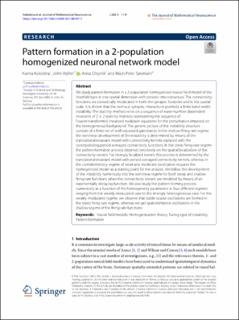| dc.contributor.author | Kolodina, Karina | |
| dc.contributor.author | Wyller, John Andreas | |
| dc.contributor.author | Oleynik, Anna | |
| dc.contributor.author | Sørensen, Mads Peter | |
| dc.date.accessioned | 2022-01-18T14:06:30Z | |
| dc.date.available | 2022-01-18T14:06:30Z | |
| dc.date.created | 2021-06-26T13:31:15Z | |
| dc.date.issued | 2021 | |
| dc.identifier.issn | 2190-8567 | |
| dc.identifier.uri | https://hdl.handle.net/11250/2838018 | |
| dc.description.abstract | We study pattern formation in a 2-population homogenized neural field model of the Hopfield type in one spatial dimension with periodic microstructure. The connectivity functions are periodically modulated in both the synaptic footprint and in the spatial scale. It is shown that the nonlocal synaptic interactions promote a finite band width instability. The stability method relies on a sequence of wave-number dependent invariants of 2×2-stability matrices representing the sequence of Fourier-transformed linearized evolution equations for the perturbation imposed on the homogeneous background. The generic picture of the instability structure consists of a finite set of well-separated gain bands. In the shallow firing rate regime the nonlinear development of the instability is determined by means of the translational invariant model with connectivity kernels replaced with the corresponding period averaged connectivity functions. In the steep firing rate regime the pattern formation process depends sensitively on the spatial localization of the connectivity kernels: For strongly localized kernels this process is determined by the translational invariant model with period averaged connectivity kernels, whereas in the complementary regime of weak and moderate localization requires the homogenized model as a starting point for the analysis. We follow the development of the instability numerically into the nonlinear regime for both steep and shallow firing rate functions when the connectivity kernels are modeled by means of an exponentially decaying function. We also study the pattern forming process numerically as a function of the heterogeneity parameters in four different regimes ranging from the weakly modulated case to the strongly heterogeneous case. For the weakly modulated regime, we observe that stable spatial oscillations are formed in the steep firing rate regime, whereas we get spatiotemporal oscillations in the shallow regime of the firing rate functions. | en_US |
| dc.language.iso | eng | en_US |
| dc.publisher | Springer | en_US |
| dc.rights | Navngivelse 4.0 Internasjonal | * |
| dc.rights.uri | http://creativecommons.org/licenses/by/4.0/deed.no | * |
| dc.title | Pattern formation in a 2-population homogenized neuronal network model | en_US |
| dc.type | Journal article | en_US |
| dc.type | Peer reviewed | en_US |
| dc.description.version | publishedVersion | en_US |
| dc.rights.holder | Copyright 2021 The Author(s) | en_US |
| dc.source.articlenumber | 9 | en_US |
| cristin.ispublished | true | |
| cristin.fulltext | original | |
| cristin.qualitycode | 1 | |
| dc.identifier.doi | 10.1186/s13408-021-00107-1 | |
| dc.identifier.cristin | 1918688 | |
| dc.source.journal | The Journal of Mathematical Neuroscience | en_US |
| dc.identifier.citation | The Journal of Mathematical Neuroscience. 2021, 11, 9. | en_US |
| dc.source.volume | 11 | en_US |

